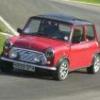
Electrical speedo
#46

Posted 13 January 2009 - 02:55 PM
#47

Posted 17 January 2009 - 04:14 PM
Ethel, that would be a fun project if I didn't have so many others. There was a guy who started a similar thread earlier this month who was developing his own digital tachometer. He posted a video link to a digital speedo he's already built. This would be ideal for his application... but it looks like he's already got a sending unit.
#48

Posted 21 January 2009 - 10:27 AM
If you work in a major corporation the term "Black belt" probably means something completely different......... But yes I get your point, if you are sufficiently skilled or creative you could use any pulse train to drive a visual readout, be that digital or analogue. I'm not familiar with an Arduino board so I can't comment on that !!
Doug
I'll respond to your PM, sorry I've not responded sooner but both work and home life have been busy the past few days !!
In brief though I've spoken back with Mathew at Salies and he said they would be happy to replicate the sensor they made for me if asked. The description is : Hunter Transducer FX4H (supplied with 3mm square drive pin) and my invoice number is : 29993. Mathew said that they would probably need both the description and invoice number as like any production based company the volume of sensors he deals with means he'll probably have forgotten about it by the time anyone askes him for one !! Having said that he remembered both my order and email converstations with you Doug when prompted, so maybe it'll stick in his mind !!
Phil.
#49

Posted 21 January 2009 - 01:25 PM
Ethel, you prompted me to spend some time last weekend working on my long dormant tachometer circuit. I didn't get a lot done... but it was still tremendous progress considering I haven't touched it in six months !
#50

Posted 21 January 2009 - 03:50 PM
Lastly, the binnacle in the back of the picture is a used unit I picked up off eBay just to have. The speedometer in it is a hybrid. It's a Smiths housing but I've transplanted a VDO speedometer with custom face behind the glass. You'll notice the odometer window is an LCD screen. My intention is to install that gauge in my next Mini project.
Wow, thats exactly what I need, I've even got a spares smiths speed. How hard was it to build and have you got anymore pics of it as I fancy building one myself. What model VDO did you use to fit it so perfectly. Are they relatively easy to set to the correct speed do you know?
I am also interested in converting my classic mini gauge into a digital one for my VTEC project - but I don't want any LCD as I think it is to complicated for me to do.
Does anyone know about an X cable that you connect to the output of the gauge - I know about X cables that work the other way around but none of the kind I need.
Originally I though of using the Honda technometer and just keeping the gauge face but getting an X cable would be so much easier
#51

Posted 21 January 2009 - 05:01 PM
Just thought this might be of interest. I've been messing about trying to find a low-tech way of driving a rev counter and speedo for my electric mini conversion. It won't have a gearbox, so that simplifies things a bit. I already had a Jaeger electronique rev counter, which normally takes a signal from the primary side of the coil. I taped a couple of magnets on opposite sides of the shaft of one of my drive motors and connected a reed switch between the coil terminal and the positive supply to the tach. The idea is that when you bring the reed switch close to the rotating shaft it's triggered each time a magnet passes. It didn't work at first, but then I realised the rev counter probably expects to see a bit more than 12V since it gets an inductive kick from the coil. I tried it again with a 24V supply to the coil terminal and it works great!
I've also read that this can be done with a hall sensor instead of a reed switch, but that's purple belt stuff... I'm sure someone with a bit of electronics skill could set it up so that it runs off 12V. On a 'normal' mini the magnets could be mounted on the inboard end of a drive shaft for a speedo drive.
Edited by MalcolmB, 21 January 2009 - 05:02 PM.
#52

Posted 21 January 2009 - 06:03 PM
I already had a Jaeger electronique rev counter, which normally takes a signal from the primary side of the coil.
? British Jaeger or French/Continental? All the British Jaeger tachs I've seen have been mechanical. Do you have pictures (both front and back)?
I taped a couple of magnets on opposite sides of the shaft of one of my drive motors and connected a reed switch between the coil terminal and the positive supply to the tach.
If this really is a voltage sensing tach (single wire hookup to coil (-) on most cars) you don't want to open and close the positive supply to the tach. The tach should have an earth connection and a switched +12V supply just to operate the movement. There should be an addition sensing lead for the input... the coil (-) connection wire. Connect one side of your reed switch to the +12V supply, connect the other side of your reed switch to a dropping resistor (perhaps something around 5000 Ohms). Finally, connect the other side of the resistor to earth. Take the sense wire from the tach and connect it to the reed switch side of the resistor. Now each time the reed switch opens and closes the tach's sense wire will see the voltage swing between 12V and 0V.
I've also read that this can be done with a hall sensor instead of a reed switch, but that's purple belt stuff... I'm sure someone with a bit of electronics skill could set it up so that it runs off 12V. On a 'normal' mini the magnets could be mounted on the inboard end of a drive shaft for a speedo drive.
You can indeed trigger most voltage pulse sensing tachs will Hall Effect sensor or other 3-wire devices. Basically it's similar to the reed switch circuit I described above where you have a dropping resistor. The Hall Effect device will have dedicated power and earth connections. It's output lead is then connected to a pull-up or pull-down resistor (depending on whether the Hall Effect device is a PNP or NPN type). The sense wire from the tach is then hooked to the output terminal of the Hall Effect device. The results are the same... as the sensor turns on and off the tach's sense wire will see a voltage swing between 12V and 0V.
#53

Posted 21 January 2009 - 07:58 PM
It's French. Here's an identical meter: http://cgi.ebay.co.u...em=280299553126British Jaeger or French/Continental? All the British Jaeger tachs I've seen have been mechanical. Do you have pictures (both front and back)?
Thanks, I'll try hooking it up with the resistor as you describe and see if it makes any difference.
Edited by MalcolmB, 21 January 2009 - 07:59 PM.
#54

Posted 21 January 2009 - 09:16 PM
I was looking online for a quick sketch to show what I was talking about regarding the gauge connection. I didn't find an exact one but take a look at this JPG.
http://www.imagineer...cs/highzrvr.gif
In that circuit, replace the photo-diode with your reed switch. Pretend the op-Amp isn't there, you don't need it. The point marked "signal out" is where the sense wire for the tach will connect.
As shown in the back view of the tach in the eBay link, connect 12V switched power to the tach's (+) terminal and connect an earth wire to the tach's (-) terminal. The tach terminal marked "coil" is the sense wire I keep mentioning.
Incidentally, do you realize that to get this to be an accurate speedo for your electric vehicle you'll have to increase or decrease the number of magnets to set the calibration?
A very, very good alternative to your tach circuit is to change to one of two solutions.
1) buy a Sigma BC1600L bicycle computer and use it instead. It's cheap, reliable, accurate, and programmable. On a Mini they will be useful up to about 100 MPH. The Sigma BC1600L looks like this: http://www.reikercyc...t/736_small.gif
2) buy a used VDO speedo from their "437" series. They are regularly on eBay over here (used) and are often a great buy. I'm not endorsing this vendor, but visit this web site to see the VDO speedos I'm talking about. There are multiple styles available (80mm, 100mm, black face, white face, different bezel types...)
http://www.etbinstru...m/VDO_Range.htm
Another thing that both the Sigma or VDO offer that is NOT on the Jaeger tach... is an odometer and trip meter.
Edited by dklawson, 21 January 2009 - 09:19 PM.
#55

Posted 21 January 2009 - 10:01 PM
The point about changing the number of magnets to calibrate the speedo is a good one. By sheer coincidence I'm gearing the mini so that at 5000 rpm it will be doing 75 mph. This means that if I fit three magnets to the motor shaft the rev counter should give a pretty accurate speed reading, since it will read 50% higher than the true motor speed. Sometimes things just work out nice
#56

Posted 22 January 2009 - 12:24 AM
I'm gearing the mini so that at 5000 rpm it will be doing 75 mph. This means that if I fit three magnets to the motor shaft the rev counter should give a pretty accurate speed reading,
I suggest bench testing that before you install this in your project car. Three magnets at 5000 RPM is equivalent to 250Hz. Some reed switches can't operate that fast (after all, it's a mechanical switch of sorts). However, if the reed switch won't work at that speed, consider eBay again and look for 3-wire proximity switches.
For example, go to ebay.co.uk and look up item number 170293184273. That's an PNP proximity sensor with cable and the buy-it-now price is under 6 GBP. The only bad thing about this one is that it's barrel is 18mm in diameter. I'd look for similar sensors either 8mm or 12mm in diameter.
#57

Posted 22 January 2009 - 08:41 AM
Sorry for hijacking your thread Chris
Edited by MalcolmB, 22 January 2009 - 08:51 AM.
#58

Posted 23 January 2009 - 07:49 PM
2 user(s) are reading this topic
0 members, 2 guests, 0 anonymous users
















